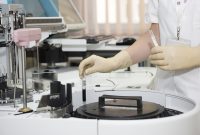-
Table of Contents
- Introduction
- How Autonomous Drones are Revolutionizing the Delivery Industry
- Autonomous Drones: The Future of Surveillance and Security
- Autonomous Drones: The Potential for Automated Farming
- Autonomous Drones: The Benefits of Automated Mapping and Surveying
- Autonomous Drones: The Impact on Search and Rescue Operations
- Conclusion
“Unlock the Possibilities of Autonomous Drones: Explore New Horizons!”
Introduction
Autonomous drones are becoming increasingly popular in a variety of industries, from photography to agriculture. Autonomous drones are unmanned aerial vehicles (UAVs) that are programmed to fly and navigate without the need for a human operator. They are equipped with sensors, cameras, and other technologies that allow them to autonomously detect and avoid obstacles, as well as follow predetermined flight paths. Autonomous drones can be used for a variety of applications, from photography and videography to surveying and mapping, search and rescue, and even agricultural applications. In this article, we will explore the various applications of autonomous drones and how they are being used to revolutionize the way we work.
How Autonomous Drones are Revolutionizing the Delivery Industry

The delivery industry is undergoing a revolution, and autonomous drones are at the forefront of this transformation. Autonomous drones are unmanned aerial vehicles (UAVs) that are capable of navigating and completing tasks without the need for human intervention. These drones are revolutionizing the delivery industry by providing faster, more efficient, and cost-effective delivery services.
Autonomous drones are equipped with advanced sensors and navigation systems that allow them to navigate complex environments and avoid obstacles. This allows them to deliver packages quickly and accurately, without the need for a human pilot. Additionally, autonomous drones are capable of carrying heavier payloads than traditional delivery methods, allowing them to deliver larger packages with greater efficiency.
Autonomous drones are also more cost-effective than traditional delivery methods. They require less fuel and maintenance, and they can be operated at a fraction of the cost of traditional delivery services. This makes them an attractive option for businesses looking to reduce their delivery costs.
Finally, autonomous drones are safer than traditional delivery methods. They are equipped with advanced safety features that allow them to detect and avoid obstacles, as well as detect and avoid other aircraft. This makes them a much safer option for delivering packages than traditional methods.
Autonomous drones are revolutionizing the delivery industry by providing faster, more efficient, and cost-effective delivery services. They are also safer than traditional delivery methods, making them an attractive option for businesses looking to reduce their delivery costs. As the technology continues to improve, autonomous drones will become even more capable and efficient, further revolutionizing the delivery industry.
Autonomous Drones: The Future of Surveillance and Security
Autonomous drones are quickly becoming the future of surveillance and security. These unmanned aerial vehicles (UAVs) are equipped with advanced sensors and cameras that can be used to monitor and protect large areas. They are also capable of performing complex tasks such as search and rescue operations, border patrol, and even firefighting.
The use of autonomous drones for surveillance and security is becoming increasingly popular due to their cost-effectiveness and efficiency. They can be deployed quickly and can cover large areas in a short amount of time. They are also able to operate in hazardous environments, such as in the aftermath of natural disasters.
Autonomous drones are also capable of performing complex tasks such as facial recognition, object detection, and motion tracking. This makes them ideal for use in security applications, as they can detect potential threats before they become a problem. They can also be used to monitor large crowds and detect suspicious activity.
The use of autonomous drones for surveillance and security is not without its drawbacks. Privacy concerns have been raised, as these drones can be used to monitor people without their knowledge or consent. Additionally, there are concerns about the accuracy of the data collected by these drones, as well as the potential for misuse.
Despite these drawbacks, autonomous drones are quickly becoming the future of surveillance and security. They are cost-effective, efficient, and capable of performing complex tasks. As technology continues to advance, these drones will become even more capable and reliable. It is clear that autonomous drones are the future of surveillance and security, and they will continue to play an important role in keeping our communities safe.
Autonomous Drones: The Potential for Automated Farming
The agricultural industry is undergoing a revolution, and autonomous drones are at the forefront of this transformation. Autonomous drones are unmanned aerial vehicles (UAVs) that are capable of performing tasks without human intervention. These drones are being used to automate farming processes, such as crop monitoring, soil analysis, and weed control.
The potential for automated farming is immense. Autonomous drones can be used to monitor crops in real-time, allowing farmers to quickly identify and address any issues that may arise. This can help farmers optimize their crop yields and reduce the amount of time and money spent on manual labor.
Autonomous drones can also be used to analyze soil conditions and detect nutrient deficiencies. This can help farmers identify areas of their fields that need additional fertilizer or other treatments. Additionally, drones can be used to detect and control weeds, reducing the need for manual labor and chemical treatments.
Finally, autonomous drones can be used to monitor weather conditions and provide early warnings of potential storms or other weather-related issues. This can help farmers prepare for adverse weather conditions and minimize the impact on their crops.
The potential for automated farming is immense, and autonomous drones are at the forefront of this revolution. By leveraging the power of autonomous drones, farmers can optimize their crop yields, reduce manual labor, and prepare for adverse weather conditions. As the technology continues to evolve, the possibilities for automated farming are only going to increase.
Autonomous Drones: The Benefits of Automated Mapping and Surveying
The use of autonomous drones for mapping and surveying is becoming increasingly popular in a variety of industries. Autonomous drones are unmanned aerial vehicles (UAVs) that are programmed to fly autonomously, without the need for a human operator. This technology has revolutionized the way mapping and surveying is done, providing a number of benefits over traditional methods.
One of the primary benefits of using autonomous drones for mapping and surveying is the speed and accuracy of the data collected. Autonomous drones can be programmed to fly predetermined routes, allowing them to cover large areas quickly and accurately. This eliminates the need for manual surveying, which can be time-consuming and prone to errors. Additionally, autonomous drones can be programmed to collect data from multiple sensors, such as cameras, LiDAR, and thermal imaging, allowing for more comprehensive data collection.
Another benefit of using autonomous drones for mapping and surveying is the cost savings. Autonomous drones are much cheaper to operate than traditional methods, such as manned aircraft or helicopters. Additionally, the data collected by autonomous drones is often more accurate and detailed than that collected by traditional methods, allowing for more efficient decision-making.
Finally, autonomous drones are safer than traditional methods. Autonomous drones can be programmed to fly at predetermined altitudes and speeds, eliminating the risk of human error. Additionally, autonomous drones can be programmed to avoid obstacles, such as power lines and buildings, reducing the risk of accidents.
Overall, the use of autonomous drones for mapping and surveying provides a number of benefits over traditional methods. Autonomous drones are faster, more accurate, and safer than traditional methods, while also providing cost savings. As the technology continues to improve, autonomous drones will become an increasingly popular tool for mapping and surveying.
Autonomous Drones: The Impact on Search and Rescue Operations
The use of autonomous drones in search and rescue operations has the potential to revolutionize the way we respond to emergencies. Autonomous drones are unmanned aerial vehicles (UAVs) that are programmed to fly autonomously, without the need for a human operator. They are equipped with sensors and cameras that can be used to locate missing persons, assess hazardous environments, and provide real-time data to emergency responders.
The use of autonomous drones in search and rescue operations has several advantages over traditional methods. First, they can cover large areas quickly and efficiently, allowing responders to quickly locate missing persons or assess hazardous environments. Second, they can be deployed in difficult-to-reach areas, such as mountainous terrain or dense forests, where traditional search and rescue methods may be impractical or impossible. Third, they can provide real-time data to responders, allowing them to make informed decisions in a timely manner.
Autonomous drones also have the potential to reduce the risk to responders. By using drones to assess hazardous environments, responders can avoid putting themselves in danger. Additionally, autonomous drones can be used to provide real-time data to responders, allowing them to make informed decisions without having to enter the hazardous environment.
Finally, autonomous drones can be used to provide assistance to responders in the form of aerial surveillance. By using drones to monitor an area, responders can quickly identify potential threats and respond accordingly.
The use of autonomous drones in search and rescue operations has the potential to revolutionize the way we respond to emergencies. By providing real-time data, reducing the risk to responders, and providing aerial surveillance, autonomous drones can help responders locate missing persons and assess hazardous environments more quickly and efficiently. As the technology continues to develop, autonomous drones will become an increasingly important tool in search and rescue operations.
Conclusion
Autonomous drones have the potential to revolutionize the way we interact with the world around us. From photography to delivery services, autonomous drones can provide a wide range of applications that can benefit both businesses and individuals. With the right technology and regulations in place, autonomous drones can become an integral part of our lives, providing us with a new level of convenience and efficiency.















